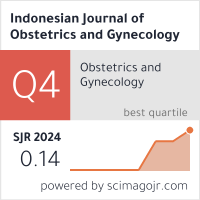Leptin Expression in High-grade Serous Ovarian Carcinoma: The Controversy of Leptin Paradox in Ovarian Cancer
Abstract
Objectives : To analyse the characteristics and expression patterns of Leptin in high-grade serous epithelial ovarian carcinoma (HGSC), and to compare them with the overall serous ovarian carcinoma population.
Methods : This was a cross-sectional study. A total of 77 paraffin-embedded tissue samples were collected from patients at the Wahidin Sudirohusodo Hospital over a period of 3 years. Immunohistochemical staining was performed using a polyclonal Leptin antibody. Data were analyzed using SPSS version 22.0.
Results: Among HGSC patients, the majority (64.3%) were over 50 years old, and a significant portion (39.3%) were obese. Leptin showed strong cytoplasmic expression in 69.6% of HGSC tumor cells and in 100% of LGSC tumor cells (p-value = 0.004). There was no correlation between lymphovascular space invasion and leptin expression. Interestingly, leptin expression in overall serous ovarian carcinoma patients exhibited a protective effect against metastasis (p-value = 0.047), suggesting a leptin paradox exists in this type of cancer. However, this association was no longer significant when the analysis excluded the LGSC group (p-value = 0.193).
Conclusion : This study suggest that leptin expression may not be a significant prognostic factor in HGSC. The appearance of the pseudo-leptin paradox phenomenon in several previous studies was confounded by sample populations with heterogeneous tumor morphology.
Keywords: high-grade serous carcinoma, leptin paradox, immunohistochemistry, leptin, obesity
Downloads
Copyright (c) 2025 Indonesian Journal of Obstetrics and Gynecology

This work is licensed under a Creative Commons Attribution-NonCommercial-ShareAlike 4.0 International License.













